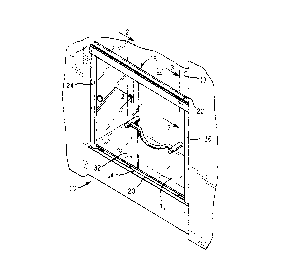Some of the information on this Web page has been provided by external sources. The Government of Canada is not responsible for the accuracy, reliability or currency of the information supplied by external sources. Users wishing to rely upon this information should consult directly with the source of the information. Content provided by external sources is not subject to official languages, privacy and accessibility requirements.
Any discrepancies in the text and image of the Claims and Abstract are due to differing posting times. Text of the Claims and Abstract are posted:
| (12) Patent: | (11) CA 2242043 |
|---|---|
| (54) English Title: | ANTI-DERAILING MECHANISM FOR TRACK MOUNTED BATH DOORS |
| (54) French Title: | MECANISME ANTI-DERAILLEMENT POUR PORTES DE BAIGNOIRE MONTEES SUR GLISSIERE |
| Status: | Expired and beyond the Period of Reversal |
| (51) International Patent Classification (IPC): |
|
|---|---|
| (72) Inventors : |
|
| (73) Owners : |
|
| (71) Applicants : |
|
| (74) Agent: | MARKS & CLERK |
| (74) Associate agent: | |
| (45) Issued: | 2003-04-01 |
| (86) PCT Filing Date: | 1996-12-19 |
| (87) Open to Public Inspection: | 1997-07-17 |
| Examination requested: | 2000-12-13 |
| Availability of licence: | N/A |
| Dedicated to the Public: | N/A |
| (25) Language of filing: | English |
| Patent Cooperation Treaty (PCT): | Yes |
|---|---|
| (86) PCT Filing Number: | PCT/US1996/020708 |
| (87) International Publication Number: | WO 1997025506 |
| (85) National Entry: | 1998-07-02 |
| (30) Application Priority Data: | ||||||
|---|---|---|---|---|---|---|
|
A door system (15) for a bathing enclosure which includes a track (22)
extending above an opening of the enclosure with the track having a rail (34)
with an upper surface having a longitudinal groove (38). A door (31) has first
and second rollers (42, 72) which ride in the rail groove (38), so that the
door (31) is suspended from and slidable along the track (22). A separate stop
is associated with each roller (42, 72) with each stop having a locking
bracket (60) fixed to the door (31) and a member (64, 74) is movably attached
to the locking bracket. The members (64, 74) are adjustable between a first
position at which the respective roller (42, 72) may be removed from the
groove (38) and a second position at which the member strikes the track (22)
before the respective roller (42, 72) can be removed from the groove (38).
Système (15) de porte pour enceinte de baignoire comprenant une glissière (22) s'étendant au-dessus d'une ouverture de l'enceinte, cette glissière étant pourvue d'un rail (34) comportant dans sa surface supérieure une rainure longitudinale (38). Une porte (31) possède des première et seconde roulettes (42, 72) qui chevauchent la rainure (38) de sorte que la porte (31) soit suspendue et puisse coulisser le long de la glissière (22). Une butée séparée est associée à chaque roulette (42, 72) et comporte une tige de verrouillage (60) fixée à la porte (31), et un élément (64, 74) est fixé amovible à la tige de verrouillage. Ces éléments (64, 74) peuvent se régler entre une première position dans laquelle la roulette respective (42, 72) peut être retirée de la rainure (38) et une seconde position dans laquelle l'élément heurte la glissière (22) avant que la roulette respective (42, 72) puisse être retirée de la rainure (38).
Note: Claims are shown in the official language in which they were submitted.
Note: Descriptions are shown in the official language in which they were submitted.

2024-08-01:As part of the Next Generation Patents (NGP) transition, the Canadian Patents Database (CPD) now contains a more detailed Event History, which replicates the Event Log of our new back-office solution.
Please note that "Inactive:" events refers to events no longer in use in our new back-office solution.
For a clearer understanding of the status of the application/patent presented on this page, the site Disclaimer , as well as the definitions for Patent , Event History , Maintenance Fee and Payment History should be consulted.
| Description | Date |
|---|---|
| Time Limit for Reversal Expired | 2013-12-19 |
| Letter Sent | 2012-12-19 |
| Inactive: IPC from MCD | 2006-03-12 |
| Grant by Issuance | 2003-04-01 |
| Inactive: Cover page published | 2003-03-31 |
| Inactive: Final fee received | 2003-01-03 |
| Pre-grant | 2003-01-03 |
| Notice of Allowance is Issued | 2002-07-03 |
| Letter Sent | 2002-07-03 |
| Notice of Allowance is Issued | 2002-07-03 |
| Inactive: Prior art correction | 2002-07-03 |
| Inactive: Approved for allowance (AFA) | 2002-06-20 |
| Amendment Received - Voluntary Amendment | 2001-09-10 |
| Letter Sent | 2001-01-08 |
| Request for Examination Requirements Determined Compliant | 2000-12-13 |
| All Requirements for Examination Determined Compliant | 2000-12-13 |
| Request for Examination Received | 2000-12-13 |
| Inactive: Single transfer | 1998-12-04 |
| Inactive: IPC assigned | 1998-10-09 |
| Inactive: First IPC assigned | 1998-10-09 |
| Inactive: IPC assigned | 1998-10-06 |
| Classification Modified | 1998-10-06 |
| Inactive: IPC assigned | 1998-10-06 |
| Inactive: Courtesy letter - Evidence | 1998-09-22 |
| Inactive: Notice - National entry - No RFE | 1998-09-17 |
| Application Received - PCT | 1998-09-09 |
| Application Published (Open to Public Inspection) | 1997-07-17 |
There is no abandonment history.
The last payment was received on 2002-11-22
Note : If the full payment has not been received on or before the date indicated, a further fee may be required which may be one of the following
Please refer to the CIPO Patent Fees web page to see all current fee amounts.
Note: Records showing the ownership history in alphabetical order.
| Current Owners on Record |
|---|
| KOHLER CO. |
| Past Owners on Record |
|---|
| MICHAEL J. KURTH |